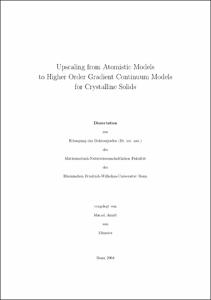Upscaling from Atomistic Models to Higher Order Gradient Continuum Models for Crystalline Solids

Upscaling from Atomistic Models to Higher Order Gradient Continuum Models for Crystalline Solids

| dc.contributor.advisor | Griebel, Michael | |
| dc.contributor.author | Arndt, Marcel | |
| dc.date.accessioned | 2020-04-06T23:00:15Z | |
| dc.date.available | 2020-04-06T23:00:15Z | |
| dc.date.issued | 2004 | |
| dc.identifier.uri | https://hdl.handle.net/20.500.11811/2122 | |
| dc.description.abstract | In this work a new upscaling scheme for the derivation of a continuum mechanical model from an atomistic model for crystalline solids is developed. The scheme, called the inner expansion technique, is based on a Taylor series expansion of the deformation function and leads to a continuum mechanical model which involves higher order derivatives. It provides an approximation of the atomistic model within the quasi-continuum regime and allows to capture the microscopic material properties and the discreteness effects of the underlying atomistic system up to an arbitrary order. The quality of approximation is investigated for the model problem of an atomic chain with different types of potentials, including many-body potentials. The outcome of the inner expansion technique is numerically compared to other upscaling techniques, namely the classical thermodynamic limit and the direct expansion technique. It is shown that our technique carries over certain properties such as convexity from the atomistic to the continuum mechanical level, which results in well-posed problems on the continuum mechanical level. Furthermore, macroscopic approximation techniques are discussed to reduce the complexity of the continuum model. The upscaling technique is applied to the Stillinger-Weber potential for crystalline silicon and to the potential given by the Embedded-Atom Method (EAM) for shape memory alloys (SMA). Numerical simulations of the dynamic response of a silicon crystal and of one-way and two-way SMA micro-actuators are performed. | |
| dc.language.iso | eng | |
| dc.rights | In Copyright | |
| dc.rights.uri | http://rightsstatements.org/vocab/InC/1.0/ | |
| dc.subject | Innere Expansionstechnik | |
| dc.subject | Ableitung höherer Ordnung | |
| dc.subject | Quasi-Kontinuums-Regime | |
| dc.subject | Hochskalierung | |
| dc.subject | Kontinuums-Limes | |
| dc.subject | Mehrskalensimulation | |
| dc.subject | Molekulardynamik | |
| dc.subject | Kontinuumsmechanik | |
| dc.subject | inner expansion technique | |
| dc.subject | higher order derivative | |
| dc.subject | quasi-continuum regime | |
| dc.subject | upscaling | |
| dc.subject | continuum limit | |
| dc.subject | multiscale simulation | |
| dc.subject | molecular dynamics | |
| dc.subject | continuum mechanics | |
| dc.subject.ddc | 510 Mathematik | |
| dc.title | Upscaling from Atomistic Models to Higher Order Gradient Continuum Models for Crystalline Solids | |
| dc.type | Dissertation oder Habilitation | |
| dc.publisher.name | Universitäts- und Landesbibliothek Bonn | |
| dc.publisher.location | Bonn | |
| dc.rights.accessRights | openAccess | |
| dc.identifier.urn | https://nbn-resolving.org/urn:nbn:de:hbz:5N-04785 | |
| ulbbn.pubtype | Erstveröffentlichung | |
| ulbbnediss.affiliation.name | Rheinische Friedrich-Wilhelms-Universität Bonn | |
| ulbbnediss.affiliation.location | Bonn | |
| ulbbnediss.thesis.level | Dissertation | |
| ulbbnediss.dissID | 478 | |
| ulbbnediss.date.accepted | 11.11.2004 | |
| ulbbnediss.fakultaet | Mathematisch-Naturwissenschaftliche Fakultät | |
| dc.contributor.coReferee | Krause, Rolf |
Dateien zu dieser Ressource
Das Dokument erscheint in:
-
E-Dissertationen (4089)




